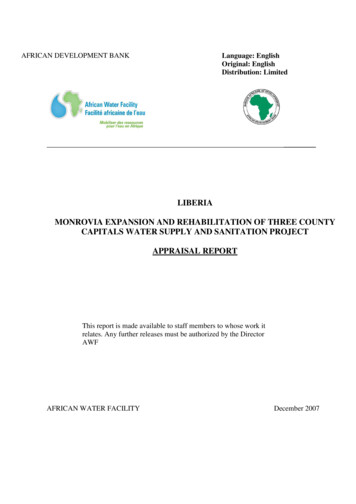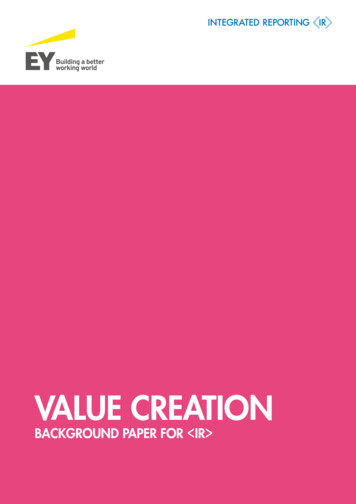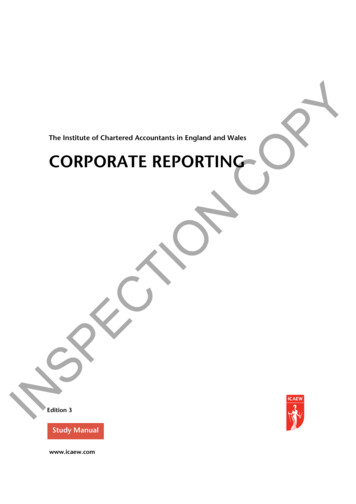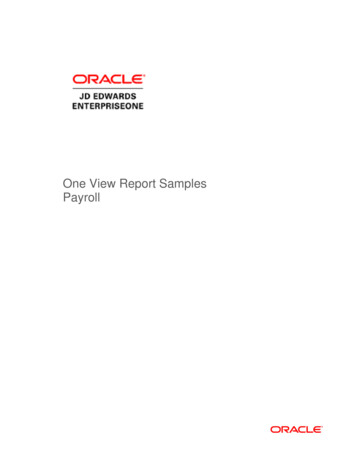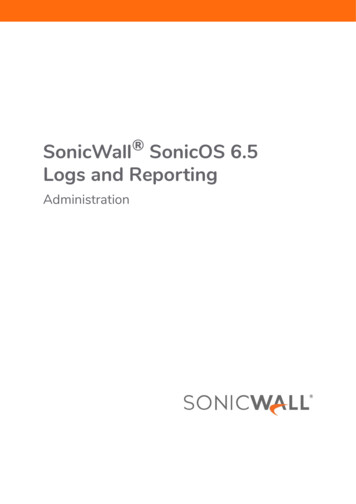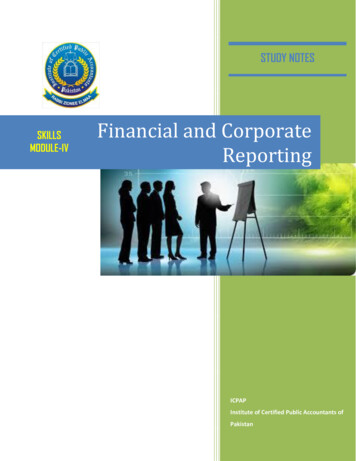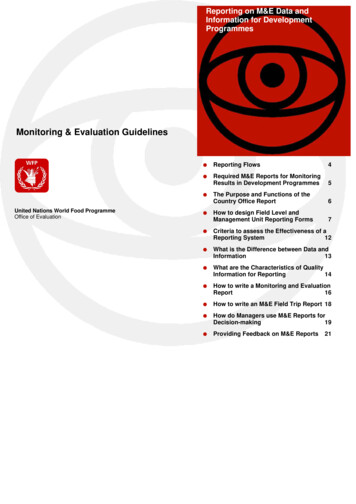
Transcription
CAPITALSBACKGROUND PAPER FOR IR 1
CAPITALS BACKGROUND PAPER FOR IR The Technical Task Force of the International Integrated Reporting Council(IIRC) established a Technical Collaboration Group (TCG) to prepare thisBackground Paper for IR . The TCG was coordinated by the leadorganizations with input from participants from a range of disciplines andcountries. This paper reflects the collective views of TCG participants, notnecessarily those of their organizations or the IIRC.The IIRC considered interim findings from the TCG when preparing thePrototype Framework released in November 2012, and is further consideringthis paper in developing a Consultation Draft of the International IntegratedReporting ( IR ) Framework. This paper provides background informationthat will assist stakeholders when responding to the Consultation Draft.The IIRC gratefully acknowledges the contributions made by the following inthe drafting of this Background Paper for IR :LEAD ORGANIZATIONSAssociation of Chartered Certified Accountants (ACCA)Netherlands Institute of Chartered Accountants (NBA)PROJECT TEAMCarol Adams, Independent consultant and Monash UniversityAndrea B. Coulson, University of StrathclydeTom Emmelkamp, Ernst & YoungRedmer Greveling, KPMGGuido Klüth, KPMGMichael Nugent, IIRC (International Federation of Accountants)STEERING GROUPMelissa Brown, Daobridge Capital LimitedRachel Jackson, ACCA (secretariat)Paul G. W. Jansen, VU University AmsterdamKenan Patrick Jarboe, Athena AllianceHenny Kapteijn, Nederlandse Beroepsorganisatie van Accountants andInternational Federation of Accountants’ Professional Accountants inBusiness CommitteeRichard Martin, ACCAAlexandre Nakamaru, NaturaJeanne Ng, China Light and PowerStefano Zambon, University of Ferrara and WICI EuropeCopyright March 2013 by the International Integrated Reporting Council. All rightsreserved. Permission is granted to make copies of this work to achieve maximumexposure provided that each copy bears the following credit line: Copyright March2013 by the International Integrated Reporting Council. All rights reserved. Used withpermission of the International Integrated Reporting Council. Permission is granted tomake copies of this work to achieve maximum exposure.ISSN: 2052-17232
CONTENTS11. Executive summary22. Introduction22A Focus of this Background Paper for IR 22B Terminology32C Experience33. Overview of the capitals33A The stock and flow of capitals43B Measurement43C Ownership of the capitals43D Availability, quality and affordability of the capitals54. Categorization and descriptions of the capitals54A The role of the capitals model in the Framework64B Meaning of the various capitals and their interrelationships134C Summary, and proposed categorization and descriptions of the capitals165. Current reporting practice165A Financial capital and manufactured capital in financial reporting165B Other capitals in financial reporting175C Natural capital, social and relationship capital, and human capital185D Intellectual capital195E Other experiences from the IIRC Pilot Programme206. Other issues and areas for further development206A Investors’ information needs216B Metrics226C Complexity and trade-offs226D Aggregation236E Reporting boundary25References
CapitalsBackground Paper for IR 1. Executive summaryThis Background Paper for IR explores the concept of multiple capitals being adopted by the InternationalIntegrated Reporting Council (IIRC).1.2 The capitals identified by the IIRC are: financial capital, manufactured capital, intellectual capital, humancapital, social and relationship capital, and natural capital. Together they represent stores of value that are thebasis of an organization’s value creation.1.3 The background to adoption of the capitals model in IIRC publications is explained in Section 2. Section 2also explains the scope of this Background Paper for IR , and discusses use of the terminology “capitals”versus “resources and relationships” and the fact that reporting on multiple capitals is a relatively new andevolving field.1.4 Section 3 provides an overview of the capitals concept. All organizations increase, decrease or transformcapitals through activities. While most organizations rely on all capitals to an extent, some dependencies willbe relatively minor or so indirect that they are immaterial for reporting purposes.1.4 Whether or not the capitals an organization uses or affects are owned by that organization, theiravailability, quality and affordability can affect the long term viability of an organization’s business model and,therefore, its ability to create value over time. This is particularly the case with respect to capitals that are inlimited supply and are non-renewable.1.5 Quantitative indicators, such as key performance indicators and in some cases, monetized metrics, can bevery important in explaining an organization’s uses of, and effects on, various capitals. Nonetheless, it is not anobjective of IR to measure all the capitals or movements in them. Many uses of, and effects on, the capitalsare best (and in some cases can only be) reported on in the form of narrative, rather than through metrics.1.6 Section 4 considers the role of the capitals model in the Integrated Reporting ( IR ) Framework (theFramework), noting that at this stage, the categorization and descriptions adopted by the IIRC are not intendedto be the only option available to preparers of integrated reports. Nonetheless, because of the central role ofthe capitals in the Framework, it is important that its categorization, and the descriptions it adopts, are soundlybased. Therefore, this section summarizes the treatment of the capitals and their interrelationships in theacademic and professional literature, and summarizes responses to the IIRC’s 2011 Discussion Paper. Itconcludes with proposals for improving the categorization and descriptions adopted by the IIRC.1.7 Section 5 reviews current reporting practice with respect to the capitals. It discusses how the capitals relateto financial reporting, both in terms of recognition on the face of the financial statements, and disclosures innotes and management commentary. It also discusses sustainability and other forms of reporting, and highlightspractical experiences from the IIRC Pilot Programme.1.8 Section 6 touches on a range of other issues and areas for future development. For example, it offerspractical examples of KPIs currently being used to report on various capitals, and an illustration of how to usethe capitals model in conjunction with stakeholder analysis when determining the reporting boundary. It alsodiscusses the issue of aggregation of capitals and notes that, apart from efforts to monetize various capitals,there appears to be no reasonable way to aggregate measures with respect to the full range of capitals, oreven the various components within any particular capital.1
2. Introduction2.1 The IIRC’s September 2011 Discussion Paper, “Towards Integrated Reporting – Communicating Value in the21st Century”1 noted that “Integrated Reporting results in a broader explanation of performance than traditionalreporting. It makes visible an organization’s use of and dependence on different resources and relationships or‘capitals’ (financial, manufactured, human, intellectual, natural and social), and the organization’s access to andimpact on them. Reporting this information is critical to: a meaningful assessment of the long-term viability of the organization’s business model and strategy;meeting the information needs of investors and other stakeholders; andultimately, the effective allocation of scarce resources.”2.2 In response to the 2011 Discussion Paper, only 2% of respondents said they did not find the concept ofmultiple capitals helpful, while 76% agreed, or agreed with qualification, that it is helpful2.2.3 The concept of multiple capitals has therefore been retained in the Prototype Framework3 issued inNovember 2012, and is expected to be retained in the Consultation Draft to be issued in April 2013.2.4 A description of each of the capitals is included in Section 4C of this Background Paper for IR .2A Focus of this Background Paper for IR 2.5 The purpose of this Background Paper for IR is to explore the application of the capitals concept toIntegrated Reporting IR . Its primary focus is the examination, in Section 4, of the categorization anddescriptions of the various capitals used in the Prototype Framework, which will both inform further developmentof the Framework and provide practical insights to reporters and others on how to apply the capitals concept.2.6 The Paper has been prepared using the collective knowledge of a small project team comprisingpractitioners, academics and IIRC staff, with invaluable input provided by a small, broadly-based steering group.2.7 There are boundaries to this Background Paper for IR . Efforts were primarily directed towards making theapplication of the capitals concept as understandable and practical as possible in terms of how the individualcapitals are categorized and described and how they relate to current reporting practice. That required a strictfocus on the capitals themselves. The impacts of a number of other issues that are briefly touched on in Section 6were, therefore, not explored in great detail.2B Terminology2.8 The term “capitals” as used in this Background Paper for IR refers broadly to any store of value that anorganization can use in the production of goods or services.2.9 The 2011 Discussion Paper used the term “capitals”. The capitals are sometimes also referred to as“resources and relationships”. Some respondents to the 2011 Discussion Paper found use of the term “capital” tobe pejorative (e.g., “Human beings, human communities and ecosystems are not merely forms of capitalprovided to companies in order to be drawn down or built up”) or too linked with financial concepts (e.g. “thechallenge with ‘multiple capitals’ is its association with economic thinking and the danger of falling back intoframing corporate reporting in terms of an economic conceptual framework”).2.10 Use of the term “capitals” versus “resources and relationships” was considered and, while acknowledgingthe concerns noted in the previous paragraph, continued use of “capitals” is supported. Using the term “capitals”emphasizes the role of the various capitals as stores of value that can be built up or run down over time, butwhich must be maintained if they are to continue to produce a flow of benefits in the rk-development/discussion-paper/22% of respondents did not answer this question. A summary of responses is available rototype-of-the-international-ir- framework/2
2C Experience2.11 The concept of explicitly considering multiple capitals when reporting is relatively new. Report preparersare still experimenting with how to categorize and define the capitals for their own circumstances, as well as theappropriate narrative and metrics to report. Report users are also exploring what information they will find mostuseful, how they would like it delivered, and in what form. While this Background Paper for IR is soundlybased on an analysis of academic research and practice to date, it is clear that reporting on the capitals is set toevolve considerably over the coming years, in part through the IIRC Pilot Programme4. This Paper aims to helpthat evolution, and makes no claim to be the definitive final word on the subject of capitals.3. Overview of the capitals3A The stock and flow of capitals3.1 All organizations depend on various forms of capital for their success. These capitals are stores of value that,in one form or another, become inputs to the organization’s business model. They are also increased, decreasedor transformed through the activities of the organization in that they are enhanced, consumed, modified orotherwise affected by those activities. For example, an organization’s financial capital is increased when itmakes a profit and its human capital is increased when employees become better trained.3.2 This Background Paper for IR explores the six categories of capital identified by the IIRC, which aredepicted in Figure 1. Together, these capitals are the basis of an organization’s value creation. As shown, thecapitals are not entirely independent. The exact nature of their interaction is a function of organizational focusand beliefs. While most organizations rely on all capitals to an extent, some dependencies will be relativelyminor or so indirect that they are immaterial for reporting ectualcapitalHumancapitalSocial andrelationshipcapitalFigure 1: This diagram is one wayto depict the capitals. Financialand manufactured capitals are theones organizations most commonlyreport on. IR takes a broaderview by also considering intellectual,social and relationship, and humancapitals (all of which are linkedto the activities of humans) andnatural capital (which providesthe environment in which the othercapitals ies-and-investors/This figure is an adaptation of the Forum for the Future’s diagram of its Five Capitals Model pitals/overview.A sample of other diagrams is available at df53
3.3 The total stock, or inventory, of capitals is not fixed over time. There is a constant flow between and withinthe capitals as they are increased, decreased or transformed. To demonstrate, using the example above wherehuman capital is increased when employees become better trained, the training is likely to have come at a costto the employer organization. In this case, therefore, the immediate effect is to both increase the organization’shuman capital and decrease its financial capital. In effect, from the organization’s point of view, financialcapital has been transformed into human capital. Such increases, decreases and transformations arehappening constantly. Ordinarily, an organization expects that the cumulative result of these flows will beadded value accruing to the organization (contributed to, in this case, through increased efficiency/effectiveness of the trained employees offsetting, over time, the immediate decrease in financial capital).Although this example is relatively simple and has been described only from the organization’s point of view,6 itdemonstrates that the capitals are interrelated and constantly in a state of flow and transformation, albeit atdifferent rates and with different net outcomes.3.4 Many activities cause flows and transformations that are far more complex than the above example, andinvolve a broader mix of capitals. Furthermore, there is often a mix of components within a capital (e.g., theuse of water and fertilizers to grow crops that are fed to livestock). Some activities can cause a net increaseto the overall stock of capitals, while others cause a net decrease.7 In many cases, it depends on whoseperspective is taken whether an activity has caused an increase or a decrease, as different parties will valuethe same effect on a capital differently (such as in the example above, where the employer’s and theemployees’ perception of the value of training is likely to differ). The perspective on value that is relevant to IR is discussed in the Prototype Framework.3B Measurement3.5 Quantitative indicators, such as key performance indicators (KPIs) and in some cases monetized metrics,can be very important in explaining an organization’s uses of and effects on various capitals. Nonetheless, it isimportant to point out at the outset that it would not be practicable to expect organizations to attempt to quantifyall capitals. It is not, therefore, an objective of IR to measure all the capitals or movements in them. Manyuses of and effects on the capitals are best (and in some cases can only be) reported on in the form of narrativerather than through metrics.3C Ownership of the capitals3.6 Not all capitals an organization uses or affects are owned by the organization. They may be owned byothers, or may not be owned at all in a legal sense (e.g., access to unpolluted air). This point is relevant to thecategorization and descriptions of the capitals as discussed in this Background Paper for IR , and is alsorelevant to the concept of value used for IR as discussed in the Prototype Framework.3D Availability, quality and affordability of the capitals3.7 The extent to which organizations, collectively or individually, are building up or running down the variouscapitals can have an important effect on the availability, quality and affordability of those capitals, particularlywith respect to capitals that are in limited supply and are non-renewable. This can affect the long term viability ofan organization’s business model and, therefore, its ability to create value over time. Disclosures about thecapitals should therefore include the factors that affect the availability, quality and affordability of relevantcapitals and the organization’s expectations of its ability to produce flows from them to meet future demand.3.8 While systems of financial reporting have inherent within them a concept of “capital maintenance”,8 there isno such well-defined concept for IR when it comes to accounting for the capitals. Nonetheless, reporting onthe implications for the organization of the availability, quality and affordability of various capitals (e.g., theopportunities and risks they pose for the organization and its strategies for dealing with them) is an importantpart of IR and is embedded in the Prototype Framework’s Content Elements as noted in paragraph 4.5.Other relevant points of view include the increase to the trainer’s financial capital due to the payment received from the employer, and the increase tosocial capital that may occur if employees use newly acquired skills to contribute to community organizations.6Although organizations aim to create value overall, this may involve the destruction or depletion of value stored in some capitals. In this Background Paperfor IR , unless otherwise stated, the term “value creation” includes instances when the overall stock, or inventory, of capitals is decreased (i.e., when valueis effectively destroyed or depleted).7See, for example, paragraphs 4.57–4.65 of IASB “Conceptual Framework for Financial Reporting uments/ConceptualFW2010vb.pdf84
4. Categorization and descriptions of the capitals4A The role of the capitals model in the Framework4.1 The Prototype Framework does not require that the categorization it adopts also be adopted by allorganizations preparing an integrated report. While it is likely that organizations will often find adopting thecapitals terminology to be an appropriate way to structure or articulate disclosures in their integrated report,the inclusion of the capitals model in the Framework is not intended to serve as the only possible model thatcan be reported against. Rather, the primary reasons for including the capitals model in the Framework arefor it to serve: As a benchmark for ensuring that organizations consider all the forms of capital that they use and affect(e.g. when describing their business model.As part of the theoretical underpinning for the concept of value, which is central to IR . As explained inthe Prototype Framework, the concept of value focuses on increases and decreases in the capitals.4.2 It would be impracticable, and indeed unnecessary, for the Framework to attempt to define every possiblestock of value exclusively and exhaustively, and in a way that attempts to cover all organizational strategies andbusiness models. The role of an integrated report is to tell the organization’s unique value creation story; thisrequires flexibility and should not be unduly bound by definitions of capitals that may not cater appropriately forthe organization’s particular approach to value creation. For example, relationships with stakeholders, which areof growing significance to the ability of organizations to create value over time, are included in the PrototypeFramework’s description of social and relationship capital.9 Some organizations could, however, think ofrelationships as a separate capital, as part of human or intellectual capital, or as inherent in, and thereforecutting across and linking, a number of the individual capitals. Similarly, the intangibles associated with brandand reputation (part of intellectual capital in the Prototype Framework), could be considered separate capitals,part of other capitals or cutting across a number of individual capitals.4.3 Regardless of how individual organizations categorize or define the capitals for their own purposes, allshould consider the categories identified in the Framework as a benchmark to ensure that they do not overlook amaterial capital that they use or affect.Disclosure in an integrated report4.4 Reporting on the capitals is embedded in the Content Elements of the Prototype Framework. For example: Consideration of the availability, quality and affordability of the capitals is included in the Content ElementOrganizational overview and operating context How the organization’s culture and ethical values are reflected in its use of and effects on the capitals, andhow the links between the organization’s strategy and its use of and effects on financial and other capitalsare used to arrive at performance-based compensation are included in the Content Element Governance Opportunities and risks relating to the continued availability, quality and affordability of relevant capitalsare included in the Content Element Opportunities and risks How the organization’s strategy and resource allocation plans affect key capitals and risk managementarrangements related to them are included in the Content Element Strategy and resource allocation A description of relevant capitals is inherent in the description required by the Content Element Business model Demonstrating the connectivity of financial performance with performance and outcomes regarding theother capitals is included in the Content Element Performance and outcomes The implications for future performance and outcomes of the availability, quality and affordability ofcapitals the organization uses, and why they are, or may be, important to the organization’s ability tocreate value over time are included in the Content Element Future outlook.The label “social capital” used in the 2011 Discussion Paper was changed to “social and relationship capital” in the Prototype Framework.This recognized the significant role of stakeholder relationships in organizational success and was consistent with interim findings of this project.95
4B Meaning of the various capitals and their interrelationshipsResearch methodology and additional references4.5 The following sections identify a number of extracts from academic and professional literature that define anddiscuss each of the capitals considered by the IIRC. They also summarize responses to the IIRC’s 2011 DiscussionPaper.104.6 The research methodology employed for the development of this Background Paper for IR , and morecomplete references to sources considered, are provided in the document ”Methods of literature review andsources”.11 Each captial has been examined from a multidisciplinary perspective, although one discipline oftenpredominates.Financial capital4.7 Financial capital is broadly understood as the pool of funds available to an organization. This includes bothdebt and equity finance. This description of financial capital focuses on the source of funds, rather than itsapplication which results in the acquisition of manufactured or other forms of capital.4.8 Interrelationships of financial capital and other capitals include: Financial capital is a medium of exchange that releases its value through conversion into other forms ofcapital. While not all capitals can be purchased, much of the literature on the other capitals considers the wayin which things that were previously regarded as non-monetary variables, in a business sense, haveincreasingly come to be monetized and commoditized such that a significant proportion of what is nowregarded as financial capital in fact relates to derivatives fundamentally based on other forms of capital(e.g., carbon and water).Manufactured capital4.9 Manufactured capital is seen as human-created, production-oriented equipment and tools. A distinction isdrawn between inventory (as a short term asset) and plant and equipment (tangible capital). Although theidentification of these items is generally agreed, their accounting treatment, particularly in terms of valuation,depreciation and taxation, is more contentious.4.10 The following quote from the Sigma Project12 offers a helpful summary of what manufactured capital is andwhy it is important, but it is worth clarifying that the concept as used in this Background Paper for IR extendsbeyond manufactured capital that is “owned, leased or controlled by an organisation” to include publicinfrastructure, such as road networks, available to the organization. “Manufactured capital refers to materialgoods and infrastructure owned, leased or controlled by an organisation that contribute to production or serviceprovision, but do not become embodied in its output. Examples include: tools, technology, machines, buildingsand all forms of infrastructure . Manufactured capital is important for the sustainable development of anorganisation in two ways. Firstly, the efficient use of manufactured capital enables an organisation to be flexible,responsive to market or societal needs, innovative and faster in getting its products and services to market.Secondly, manufactured capital and technology can reduce resource use and focus more on human creativity,thus enhancing both efficiency and sustainable development.”4.11 Although the literature’s distinction between “manufactured” and “manufacturing” capital is relativelyminor, it does offer a boundary between ecological economics (manufactured capital) and the wider disciplineof economics (manufacturing capital). The generalist economics definition of manufactured capital may beslightly narrower; many of its formulations refer to the manufacturing industry specifically, despite the fact thatmanufactured capital is used across all industry sectors. One area of specialized use is in national accounts,where information is collected about aggregate stocks and flows of capital equipment and capital goods. This,however, is little more than a macro/micro level issue of compiling the ssion-Paper’s-coverage-of-the-capitals.pdfThe references cited throughout the Background Paper for IR are illustrative only. The “Methods of literature review and sources” should be consulted for acomplete list of references used – iples/Capitals/ManufacturedCapital.asp6
4.12 One respondent to the IIRC’s 2011 Discussion Paper argued that manufactured capital might beinterpreted as referring only to factory output, and another argued that, as defined, manufactured capital iscaptured in financial reporting as tangible assets and intellectual capital as intangible. The latter respondentargued that if manufactured and intellectual capitals are to be wider, this needs to be clarified and understoodby preparers and other stakeholders.4.13 Interrelationships of manufactured capital and other capitals include: Although manufactured capitals owned by an organization typically appear in the financial statements, it isnot financial capital. Rather, manufactured capital is dependent upon the flow of financial capital to allowresources to be deployed to build it. Manufactured capital can embody significant elements of intellectual property (e.g., equipmentmanufactured using patented technology), which is a component of intellectual capital. Another term often used in place of manufactured capital is “tangible capital”, e.g., plant and equipment.Intellectual capital4.14 A 2006 report to the European Commission by the High Level Expert Group on RICARDIS13 presentssome in-depth perspectives on the concept of intellectual capital, with a particular focus on SMEs involved inresearch and development (R&D). The report recognizes that, together, intellectual capital and knowledgemanagement have garnered interest in corporate and academic settings. Key findings are detailed below: Intellectual capital is a key element in an organization’s future earning potential, with a tight link andcontingency between investment in R&D, innovation, human resources and external relationships, whichcan determine the organization’s competitive advantage. Statements on intellectual capital help provide clarity on the way in which an organization createscompetitive advantage by providing a narrative which explains issues such as value chain positioning andthe business model for value creation. Intellectual capital covers issues that are central to the organization’s future (as opposed to historic costs thatare focused on by traditional accounting), requiring consideration of a much wider range of intangibleswhen accounting for it. It is primarily about the internal reporting, management and control of a business and is necessary formanagement to communicate to external investo
1.7 Section 5 reviews current reporting practice with respect to the capitals. It discusses how the capitals relate to financial reporting, both in terms of recognition on the face of the financial statements, and disclosures in notes and management commentary. It also discusses sustainability and other forms of reporting, and highlights
